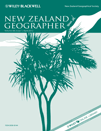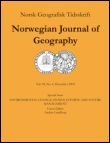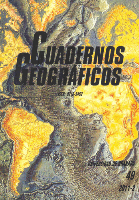
Geographical Review of Japan-Series B
Scope & Guideline
Exploring Japan's Geographic Dynamics
Introduction
Aims and Scopes
- Geographical Dynamics in Japan:
The journal emphasizes research on various geographical dynamics, including urban-rural migration, regional disparities, and population distribution, particularly within Japan. - Cultural and Social Studies:
It explores the cultural dimensions of geography, including the impact of migration on community structures and the role of religious and cultural facilities in societal integration. - Environmental and Climatic Research:
There is a consistent focus on environmental studies, particularly climatology, with an emphasis on climate change impacts, heat-related health issues, and sustainable practices in agriculture. - Economic Geography:
The journal addresses economic aspects of geography, including the distribution systems of agricultural products and the socio-economic implications of regional inequalities. - Heritage and Conservation Studies:
Research related to cultural heritage conservation and its challenges is also a critical area, as the journal seeks to understand the spatial aspects of heritage management.
Trending and Emerging
- Migration and Urbanization Studies:
Recent publications highlight the complexities of urban migration, particularly in rural Japan, indicating a growing interest in how migration shapes social dynamics and community structures. - Climate Change and Health Impacts:
There is an emerging trend focusing on the health impacts of climate change, such as heat-related mortality, which reflects a heightened awareness of public health issues linked to environmental changes. - Cultural and Religious Integration:
The role of cultural and religious facilities, particularly in the context of migrant communities, is gaining attention, showcasing the journal's interest in the intersection of geography, culture, and social integration. - Sustainability and Environmental Management:
Emerging studies on sustainable practices, particularly in agriculture and water management, indicate a shift towards addressing environmental sustainability challenges.
Declining or Waning
- Traditional Agricultural Practices:
Research focusing specifically on traditional agricultural practices in Japan appears to be waning, with fewer studies addressing this topic directly in recent years. - Historical Geographical Analyses:
There is a noticeable decline in papers that analyze historical geographical changes over long periods, suggesting a shift towards more contemporary issues. - Regional Economic Development Models:
While economic geography remains relevant, specific studies on traditional regional economic development models have decreased, indicating a possible shift towards more innovative or globalized economic analyses.
Similar Journals

European Spatial Research and Policy
Unlocking Insights into European Spatial DynamicsEuropean Spatial Research and Policy, published by LODZ UNIV PRESS, is a distinguished Open Access academic journal that has been contributing to the field of Geography, Planning, and Development since its inception in 2009. With an ISSN of 1231-1952 and an E-ISSN of 1896-1525, this journal has established itself as a vital resource for researchers and policymakers in understanding spatial dynamics and policy implications across Europe. Recognized within the 2023 Q2 category for Geography, Planning, and Development, it ranks impressively #236 out of 821 in its category on Scopus, placing it in the 71st percentile. The journal’s aim is to foster interdisciplinary dialogue and disseminate innovative research that addresses pressing spatial challenges. Since transitioning to Open Access in 2013, it has enhanced accessibility for scholars, making its rich content readily available to a global audience. Located in Lodz, Poland, European Spatial Research and Policy is poised to continue its commitment to excellence in spatial research, offering critical insights for academics, professionals, and students alike.

Perspectiva Geografica
Connecting Ideas and Empirical Research in GeographyPerspectiva Geografica is a distinguished open-access journal published by the UNIV PEDAGOGICA & TECNOLOGICA COLOMBIA, dedicated to advancing the field of geography. Launched in 2005, this journal provides a platform for researchers, academics, and practitioners to disseminate and discuss innovative ideas, empirical research, and critical analyses pertaining to geographic issues, with a special focus on Latin America. Perspectiva Geografica aims to foster interdisciplinary dialogue, encouraging contributions that explore the interplay between geographical phenomena and socio-economic dynamics. Designed for a global readership, this journal welcomes submissions that not only adhere to rigorous academic standards but also engage with pressing geographical challenges of our time. With a commitment to enhancing accessibility to quality research, Perspectiva Geografica is an essential resource for scholars and students seeking insights into both theoretical and applied geography.

Journal of Geography-Cografya Dergisi
Unlocking the World Through Geographical InsightsJournal of Geography-Cografya Dergisi, with ISSN 1302-7212 and E-ISSN 1305-2128, is an esteemed publication in the field of geography, dedicated to advancing scholarly research and knowledge in this vital discipline. Published by the Faculté des Lettres, Department of Geography at Istanbul University, this journal has embraced an Open Access policy since 2017, ensuring that cutting-edge research is freely accessible to a global audience, thereby fostering interdisciplinary collaboration and widening the dissemination of geographical studies. The journal aims to publish high-quality research articles, reviews, and case studies that address contemporary geographical challenges, methods, and innovations, appealing to researchers, professionals, and students alike. With its strategic location in Istanbul, a city that exemplifies a rich tapestry of geographical phenomena, the journal holds a vital role in connecting scholars with the diverse landscapes and cultural experiences that shape our understanding of geography. Join the vibrant community of geography enthusiasts and contribute to the ongoing dialogue within this dynamic field.

Geographica Pannonica
Connecting Research and Sustainability in a Changing WorldGeographica Pannonica is a premier, open-access journal dedicated to the various dimensions of geography, atmospheric sciences, geology, and related fields. Published by the University of Novi Sad's Faculty of Natural Sciences and Mathematics, this Serbian journal has been a vital platform for scholarly discourse since its inception, with an open-access policy established in 2010 to enhance the dissemination of research findings. Covering a spectrum of topics from Earth-surface processes to tourism management, the journal has achieved notable rankings, reflecting its commitment to impactful research—ranking in the Q3 quartile across multiple categories in 2023. Researchers, professionals, and students are encouraged to engage with the latest articles that contribute to advancing our understanding of geographical phenomena and sustainability challenges, making Geographica Pannonica an essential resource for the global academic community.

Documenti Geografici
Fostering Dialogue Across Humanities and Social SciencesDocumenti Geografici is a prestigious academic journal published by UNIV STUDI ROMA TOR VERGATA, FAC LETTERE & FILOSOFIA, specializing in interdisciplinary research bridging Economics, Geography, and History. Founded in 2019, this journal serves as a vital platform for scholars, researchers, and policymakers by disseminating innovative research findings and methodologies in the diverse fields encompassed within its scope. Currently categorized in the Q4 quartile for Economics, Econometrics and Finance (miscellaneous) and Geography, Planning and Development, and ranked in the Q3 quartile for History, Documenti Geografici offers insights that are valuable for advancing academic discourse. With its unique perspective and commitment to open dialogue, this journal is dedicated to fostering a deeper understanding of socioeconomic trends and spatial dynamics, making it an essential resource for those engaged in the humanities and social sciences. Manuscripts submitted to the journal benefit from a diligent peer-review process, ensuring high quality and relevance of published articles, thus contributing appreciably to the broader academic community.

GEOGRAFISKA ANNALER SERIES B-HUMAN GEOGRAPHY
Connecting theory and practice in human geography.GEOGRAFISKA ANNALER SERIES B-HUMAN GEOGRAPHY, published by Taylor & Francis Ltd, is a leading academic journal dedicated to advancing the field of human geography. With an ISSN of 0435-3684 and an E-ISSN of 1468-0467, this journal has established its reputation since its inception in 1976. It currently holds a prestigious Q1 ranking in Geography, Planning, and Development, reflecting its significant impact in the academic community with a Scopus rank of #243 out of 821 in its category, showcasing a 70th percentile standing among its peers. The journal aims to publish high-quality, innovative research that enhances our understanding of the complex interactions between humans and their environments. Although it operates on a subscription basis, the rigor of its peer-review process and the quality of published articles make it an essential resource for researchers, professionals, and students alike. By exploring pivotal themes in human geography, the journal not only contributes to academic discourse but also informs policy-making and practical applications in the field.

New Zealand Geographer
Fostering Scholarly Discourse in Earth SciencesNew Zealand Geographer, published by WILEY, is a distinguished academic journal that has made significant contributions to the fields of geography, planning, and earth sciences since its inception in 1945. With a dedication to advancing knowledge through rigorous research and critical analysis, the journal encompasses a broad spectrum of topics relevant to both regional and global geographies. This journal is currently indexed in Scopus, achieving commendable rankings in multiple categories, including a Q3 status in both Earth and Planetary Sciences and Geography, Planning and Development for 2023, highlighting its relevance and standing within the academic community. Although it does not currently offer open access, its commitment to providing insightful and impactful content ensures that it remains a vital resource for researchers, professionals, and students alike seeking to deepen their understanding of geographical phenomena. The journal's ongoing publication until 2024 continues to foster scholarly discourse, making it an essential platform for innovative research in geographic studies.

Norsk Geografisk Tidsskrift-Norwegian Journal of Geography
Fostering dialogue on pressing geographical challenges.Norsk Geografisk Tidsskrift-Norwegian Journal of Geography, published by Routledge Journals, Taylor & Francis Ltd, is a pivotal peer-reviewed journal that has been instrumental in advancing the field of geography since its inception in 1926. With an esteemed Q2 ranking in both Earth and Planetary Sciences and Geography, Planning and Development categories, it serves as a vital resource for researchers, professionals, and students seeking to deepen their understanding of geographical phenomena. The journal's rich historical archive, covering significant periods in geography and environmental studies, showcases a diverse array of articles that reflect ongoing research trends and challenges within the field. Despite not offering Open Access, its impactful content remains accessible through institutional subscriptions, underscoring the journal's commitment to advancing geographical research and fostering scholarly dialogue. As it continues to publish high-quality research, Norsk Geografisk Tidsskrift stands as a key player in geographical scholarship, reinforcing its importance within the academic community.

Cuadernos Geograficos
Advancing geographical knowledge for a sustainable future.Cuadernos Geograficos is a distinguished open access journal published by UNIV GRANADA in Spain, dedicated to advancing the fields of geography, planning, and earth-surface processes. With an ISSN of 0210-5462 and E-ISSN 2340-0129, this journal has been serving as an essential platform for scholars since its inception in 1983. By providing rigorous peer-reviewed research, Cuadernos Geograficos contributes significantly to the academic discourse within these disciplines, holding a respectable position in the Q3 category for both Earth-Surface Processes and Geography, Planning, and Development as of 2023. The journal is indexed in Scopus, ranking #431/821 in Social Sciences and #100/179 in Earth and Planetary Sciences, affirming its relevance and impact within the scholarly community. With its commitment to open access since 1999, Cuadernos Geograficos ensures that vital research is accessible to a diverse audience of researchers, professionals, and students, fostering knowledge sharing and collaborative advancements in the geographical sciences.

GEOJOURNAL
Bridging Theory and Practice in Urban StudiesGEOJOURNAL, published by SPRINGER, is a distinguished academic journal that occupies a pivotal role in the fields of geography, planning, and development. With a robust ISSN of 0343-2521 and an E-ISSN of 1572-9893, it has been a cornerstone of scholarly communication since its inception in 1977. Operating from the Netherlands, GEOJOURNAL offers insightful research articles that delve into the dynamics of spatial analysis, environmental management, urban studies, and regional development, thus catering to a diverse readership of researchers, professionals, and students alike. The journal boasts an impressive Scopus ranking of #176 out of 821 in its category, positioning it in the top 22% percentile while maintaining a Q2 quartile ranking in Geography, Planning, and Development as of 2023. With access options available, GEOJOURNAL remains a vital platform for disseminating cutting-edge research and fostering academic collaboration, indispensable for those engaging with contemporary geographic challenges and innovative solutions. Engage with GEOJOURNAL to enrich your understanding and contribute to critical discussions in this ever-evolving field.